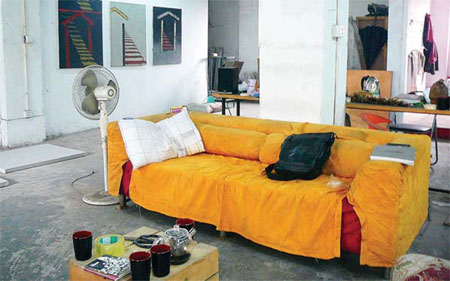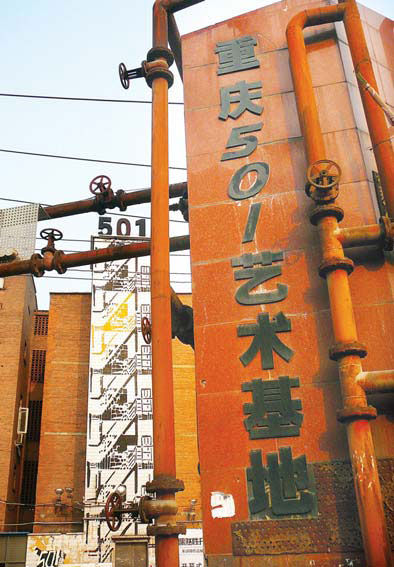Gritty reality paints promising portrait
Updated: 2012-09-07 08:06
By Richard Macauley (China Daily)
|
|||||||||
|
British painter Oliver Gosling has worked from his studio in Huangjueping since 2008. Photo Provided to China Daily |
Across the road in what appears to be a disused school, is the studio of a French artist, Vincent Cazeneuve. He too is a contemporary artist, but one with a strong and passionate link to Chinese historical craftwork.
His chosen form is Chinese lacquer, which he uses on sometimes very large canvases (propped against one wall of his studio he has a woven bed base acting as a canvas), although the finished products are far from the smooth and even surfaces of traditional lacquer work.
"Chongqing has a lot of dust and dirt - it's impossible to keep anything clean here, and that's a characteristic of the city" says Cazeneuve. "I want my art to be of Chongqing itself, so the raw materials of this city go into what I produce. I collect the ash and dust that float about, and I add them to the lacquer I apply to my pieces."
In addition to typical lacquer - and Chongqing dust - there are a host of other materials to look out for. What starts as an aesthetically pleasing image from afar becomes a fascinating combination of techniques and materials when viewed close up.
Wegrzyn, a sculptor, deals very much with the abstract.
He creates his artwork from a huge range of materials that include steel, plexiglass, bronze, wood, even water. "In the abstract, there are no borders," says Wegrzyn. "Without lines, I feel freer as there are no rules; I can explore more in the abstract form than I could in a more traditional framework."
When he moved to Chongqing, Wegrzyn studied Mandarin in Beibei, a district on the other side of the city and some two hours ride away via public transport. "I had heard about SCFAI and was starting to look at whether there were any art courses I could teach at the institute, or simply meet young artists," he says.
Change of perception
"When I discovered Huangjueping in the process, it totally changed my perception of Chongqing." Wegrzyn explains that without Huangjueping, Chongqing's industrial nature is dominant, and it is easy to believe that people are only chasing the chance to earn money as the city develops.
"I feel like my year on the other side of town was a lost year, given that I didn't know about (Huangjueping)," says Wegrzyn, only half-joking. Wanting to spend time working in the area, he arranged a residency at Organhaus and began creating sculptures in a warehouse studio in the center of Huangjueping.
Gosling, on the other hand, arrived in the district from England, after being invited by art gallery Jinse to curate an exhibition of his own paintings.
"I signed a three-year agency contract with Jinse, they put on a show and arranged the media invites," says Gosling. "I sold a painting at that first show. The buyer knew nothing about me, but appreciated my work - I've been based here ever since.
"In Germany, in the Netherlands and in other northern European countries since the 1970s, young people have bought contemporary art because they want to be a part of things. They want to participate in something," says Gosling.
"Here, there is a decent curiosity and interest in art but there is no tradition of actually buying artworks that you're fond of."
In order to strengthen habits such as this and boost the art scene for both artists and audience, Gosling says leadership and confidence are required.
Wegrzyn believes that this is happening, slowly, as China - and Chongqing in particular - progresses. "As people acquire more money, they are increasingly showing an interest in things other than work," he says. "In Germany, small artists organize things by themselves and ordinary people are attracted to come and check them out, and this is beginning to happen in Chongqing too."
"Like we see between Hong Kong and Singapore - when one city invests in art, they both invest, in the interest of keeping up. That benefits everyone."
There are some very promising signs already, he adds.
"A few months ago, I saw an artist from Taiwan auction his work. He sold around half of his work for hundreds of thousands of yuan - and that auction was located in Chongqing. If that doesn't show confidence in this city, then I don't know what does."
|
Chongqing's art district is awash with residents who have lived in the town their entire lives, as well as artists. Photo Provided to China Daily |

 Relief reaches isolated village
Relief reaches isolated village
 Rainfall poses new threats to quake-hit region
Rainfall poses new threats to quake-hit region
 Funerals begin for Boston bombing victims
Funerals begin for Boston bombing victims
 Quake takeaway from China's Air Force
Quake takeaway from China's Air Force
 Obama celebrates young inventors at science fair
Obama celebrates young inventors at science fair
 Earth Day marked around the world
Earth Day marked around the world
 Volunteer team helping students find sense of normalcy
Volunteer team helping students find sense of normalcy
 Ethnic groups quick to join rescue efforts
Ethnic groups quick to join rescue efforts
Most Viewed
Editor's Picks

|

|

|

|

|

|
Today's Top News
Health new priority for quake zone
Xi meets US top military officer
Japan's boats driven out of Diaoyu
China mulls online shopping legislation
Bird flu death toll rises to 22
Putin appoints new ambassador to China
Japanese ships blocked from Diaoyu Islands
Inspired by Guan, more Chinese pick up golf
US Weekly

|

|









